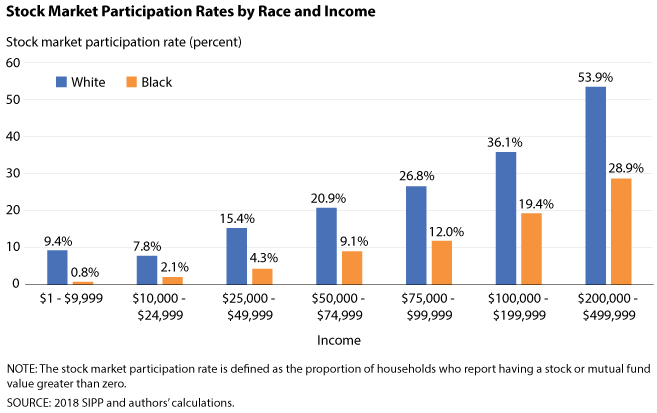OfTheCross
Veteran

The Racial Gap in Stock Market Participation
White households have a much higher stock market participation rate than Black households, which may help explain the large racial wealth gap.
Stock Market Participation Rates by Race
Chien and Bennett used data from the 2018 Survey of Income and Program Participation (SIPP). Their definition of stock market participation was based on whether the value of a household’s stocks and mutual funds was greater than zero at any point in 2017 (the survey’s reference year), they explained.Chien and Bennett found a sizable difference between the two groups’ stock market participation rates. In particular, they noted that:
- 24% of white households reported owning stock or mutual funds.
- Less than 8% of Black households reported owning stock or mutual funds.
Stock Market Participation Rates by Race and Income
Since the racial income gap may be driving the difference, the authors also examined stock market participation rates after controlling for household income level. They found that the large gap in participation rates remained under this scenario. (This can be seen in the figure below, which is from the Economic Synopses essay.)“The gap remains large for each group and even appears to widen for higher-income brackets, indicating that household income level does not account entirely for the differences in participation rates between Black and White households,” they wrote.

Chien and Bennett then looked at how much the stock market participation rate gap might close if the income distribution of Black households matched the income distribution of white households. Under this thought experiment, they found that the stock market participation rate among Black households would increase from 8% to about 11.4%—still well below the 24% rate among white households.
“Further attention should be paid to understanding the underlying causes of the difference in stock market participation rates between White and Black households as well as other contributing factors to the racial wealth gap, such as differences in retirement saving,” the authors wrote.

 You have folks posting vacation pics on FB, bunch every other week, and the list goes on. Exposure may be the mail culprit though.
You have folks posting vacation pics on FB, bunch every other week, and the list goes on. Exposure may be the mail culprit though. like i worked hard all my life and never went to an exotic place and relaxed...
like i worked hard all my life and never went to an exotic place and relaxed...
